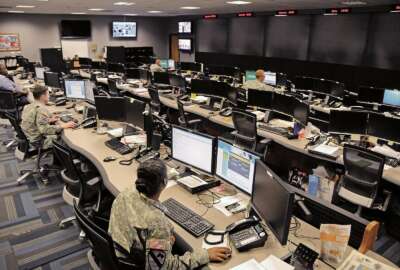

Air Force chief says the service is likely to restructure its Pentagon offices and numbered forces to combine cyber, ISR and electronic warfare.
Best listening experience is on Chrome, Firefox or Safari. Subscribe to Federal Drive’s daily audio interviews on Apple Podcasts or PodcastOne.
The Air Force is contemplating a pair of major organizational changes that it believes are needed to keep up with potential adversaries’ information warfare capabilities. Such changes extend from front-line fighting forces to the makeup of the service’s headquarters staff at the Pentagon.

For at least a year, Air Force officials have been mulling the idea of combining the two organizations that currently handle cyber, electronic warfare and intelligence functions into a single numbered Air Force. But the service is now considering a parallel change within the Pentagon offices that make up its Air Staff, said Gen. David Goldfein, the Air Force chief of staff.
No final decisions have been reached but the restructuring would combine the service’s deputy chief of staff for intelligence, surveillance and reconnaissance (A2) with the deputy chief of staff for information dominance (A6) and chief information officer.
That structure would mirror the way the Navy restructured its headquarters staff nearly a decade ago, creating a combined N2/N6 “information dominance” directorate. That moniker was recently replaced with “information warfare.”
“We’re looking at that same model going forward because as we project power forward and we look at the components that are going to work together the most, a lot of what we’re going to do – it’s going to be the Air Force and Navy and Army pushing forward together in the information domain,” Goldfein said earlier this week at a conference hosted by the National Guard Association of the U.S.
At subordinate levels of the Air Force, a plan the service has already been considering would merge the 24th Air Force, the service’s lead organization for offensive and defensive cyber, with the 25th Air Force which primarily handles intelligence, surveillance and reconnaissance. The move would mean combining cyber, intelligence and electronic warfare.
“How do you bring those three capabilities together and place them in an organization that can close seams so that we can actually improve the business of information warfare? If cyber, and intelligence, surveillance, and reconnaissance are separate, organizationally, what happens when we need to pull them together to conduct information warfare? And I wouldn’t call it information dominance because, it’s more about almost information parity,” he said. “We have both those that are out there operating in the information spaces, and as long as we are encumbered by this thing called the truth – because we actually go to war with our values – that’s always going to make it a challenge in the information domain.”
Goldfein said the combination of the 24th and the 25th Air Forces would make the most sense if it’s accompanied by similar restructuring on the Air Staff.
“So we’re doing that together,” he said. “We’re trying to get the phone book aligned so [that it is] under a single component, that component is staffed to be able to do information warfare, and then we report to all the combatant commands with an organizational model that makes sense.”
The Army is considering similar changes
The changes would build on the work that service has already done to integrate its cyber and electronic warfare functions, but take additional steps, also attempting to integrate information warfare and intelligence disciplines.
Fogarty articulated similar reasons: U.S. adversaries are already operating that way.
“How long did it take us to understand what the Russians did in 2016 to the elections? They were moving a lot faster than we were. We were occupied with an adversary by the name of ISIS, and the Russians were focused on an adversary called the United States of America,” he said. “Both sides were operating in the cyber domain and we both created effects, but in this case we were much slower, I believe, to sense, understand, decide and act. And we cannot afford to place ourselves in that position in the future, I don’t believe.”
Copyright © 2025 Federal News Network. All rights reserved. This website is not intended for users located within the European Economic Area.
Jared Serbu is deputy editor of Federal News Network and reports on the Defense Department’s contracting, legislative, workforce and IT issues.
Follow @jserbuWFED


